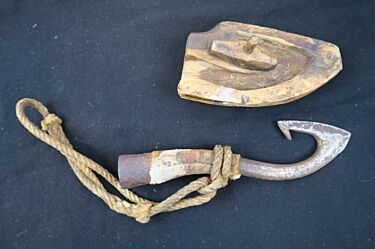
Object of the month: Harpoon (1850-1900)
Hunting in the polar regions was an important part of life for the Alta community, especially in the first half of the 20th century. The museum have received some objects which were used in the Arctic Sea. This month we have chosen to display a tool which was important for the huntsmen – a harpoon, dating back to 1850-1900. This harpoon was used for hunting walruses. It is very similar to the harpoons used by Russian seafarers in walrus hunting on Svalbard (Spitsbergen) in the period 1700-1850. As early as the 1820s men from Alta were taken on board ships to Spitsbergen where Russian crewmen taught them the skills of hunting and navigation. This type of harpoon was used from a light boat while the walruses lay sleeping in colonies on the edge of the ice. The harpoon was fastened to a rope with a long wooden handle at the other end. The harpooner would thrust the harpoon into the walrus and quickly pull on the handle. The walrus would try to escape, pulling the boat by the rope. The oarsman would tighten or loosen the rope to tire the walrus. When the fight was over the animal would be lanced and then skinned.
In as much as Johan Erik Eriksen (1895-1981) from Transfarelv was one of the owners of this harpoon we can assume that it was still being used during the first half of the 20th century.
The walrus in the north-eastern Atlantic has been a protected species since the early 1950s. A number of books and articles have been written about hunting in the Arctic seas and its importance for the Alta community. Today there is only one boat remaining which carries on seal hunting – "Havsel."
Ann-Silje Ingebrigtsen – collection staff